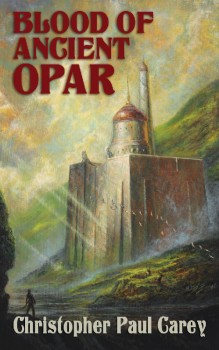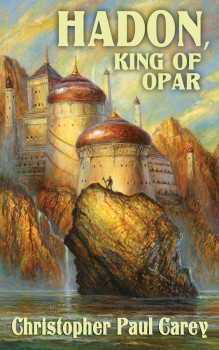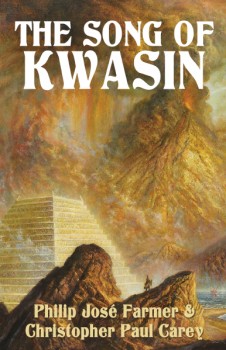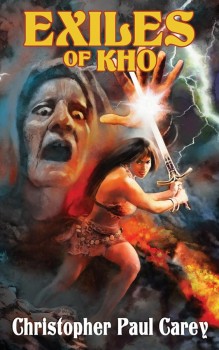An Epic Finale for Ancient Opar

 Over forty years ago, Philip Jose Farmer published a pair of officially sanctioned books recounting the history of ancient Opar, the lost civilization familiar to readers of Edgar Rice Burroughs’ Tarzan novels. Opar was the first of the author’s lost cities that survived undiscovered in the African jungle until the noble apeman came along. Burroughs’ lost civilizations, like his alien worlds, were fantastic places of adventure that allowed the author to sharpen his satiric blade and skewer organized religion and politics alike.
Over forty years ago, Philip Jose Farmer published a pair of officially sanctioned books recounting the history of ancient Opar, the lost civilization familiar to readers of Edgar Rice Burroughs’ Tarzan novels. Opar was the first of the author’s lost cities that survived undiscovered in the African jungle until the noble apeman came along. Burroughs’ lost civilizations, like his alien worlds, were fantastic places of adventure that allowed the author to sharpen his satiric blade and skewer organized religion and politics alike.
Farmer, in notable contrast, was interested in using Burroughs’ concepts as a springboard for more realistic and decidedly more adult adventures. Farmer’s histories are peopled with conquerors and king-makers who are not just noble savages, but also savage rapists and murderers. His Opar novels opened Tarzan fans’ eyes to the antediluvian kingdom of Khokarsa. While the sword & sorcery boom of the 1960s and 1970s flooded bookshelves with immoral and amoral barbarians, Farmer set his work apart by treating the material as realistically as possible. His characters die tragically and sometimes prematurely. Sexual intercourse leads to unplanned pregnancies that alter people’s lives as it changes the course of a kingdom’s destiny.

 Farmer’s Hadon of Ancient Opar (1974) and Flight to Opar (1976) wove an impressive tapestry connecting Burroughs’ Tarzan novels with H. Rider Haggard’s interrelated Allan Quatermain and Ayesha series of adventure novels. The scope of this work was more than two books and one author could do justice to in a single lifetime. This brings us to Christopher Paul Carey, a talented author and enthusiastic scholar of Farmer’s literary universe who was awarded a license from the Farmer Estate to realize the late founder of the Wold Newton universe’s vision after four decades. Carey has thus far added four more titles to the series: Exiles of Kho (2012), The Song of Kwasin (2012), Hadon, King of Opar (2015), and Blood of Ancient Opar (2016). These four books bring the initial cycle of Farmer’s Opar histories to a close, expand upon the lost kingdom’s backstory considerably, and lay the groundwork for how the series may yet develop in the future.
Farmer’s Hadon of Ancient Opar (1974) and Flight to Opar (1976) wove an impressive tapestry connecting Burroughs’ Tarzan novels with H. Rider Haggard’s interrelated Allan Quatermain and Ayesha series of adventure novels. The scope of this work was more than two books and one author could do justice to in a single lifetime. This brings us to Christopher Paul Carey, a talented author and enthusiastic scholar of Farmer’s literary universe who was awarded a license from the Farmer Estate to realize the late founder of the Wold Newton universe’s vision after four decades. Carey has thus far added four more titles to the series: Exiles of Kho (2012), The Song of Kwasin (2012), Hadon, King of Opar (2015), and Blood of Ancient Opar (2016). These four books bring the initial cycle of Farmer’s Opar histories to a close, expand upon the lost kingdom’s backstory considerably, and lay the groundwork for how the series may yet develop in the future.
Carey has succeeded admirably in conquering the two greatest challenges facing a continuation author: he has found the narrative and character voices enabling the reader to accept a new author picking up the reins decades after the fact and, perhaps even more importantly, he has crafted novels that stand on their own merit as both adventure and literature without falling prey to writing strictly for obsessive cultists. Hadon’s tale and the fate of Opar in his time (as well as its future) unfurl with a sense that Carey has stayed true to Farmer’s vision while thrilling Burroughs and Haggard readers with how effortlessly he has connected their respective worlds. Blood of Ancient Opar is a satisfying conclusion to this ambitious series, but it is also a conclusion that leaves readers eager for Carey not to close the door on Opar and Khokarsa, but to simply begin a new chapter in the continuing history of these amazing worlds. All of Christopher Paul Carey’s tales of Opar and Khokarsa are available from Meteor House.
William Patrick Maynard was authorized to continue Sax Rohmer’s Fu Manchu thrillers beginning with The Terror of Fu Manchu (2009; Black Coat Press) and The Destiny of Fu Manchu (2012; Black Coat Press). His long-delayed third title, The Triumph of Fu Manchu is coming soon from Black Coat Press.